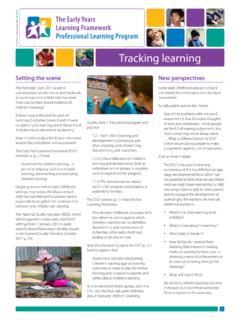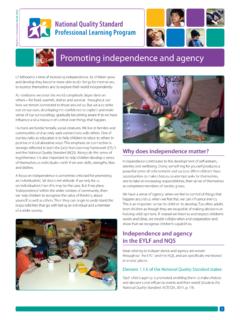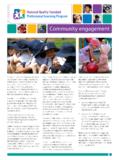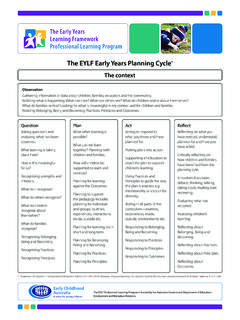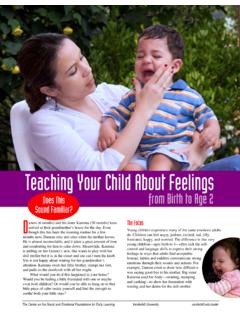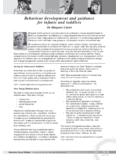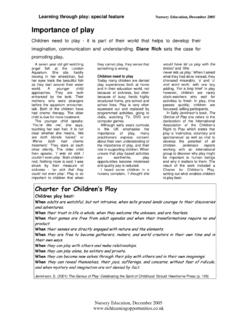Transcription of Becoming literate - Early Childhood Australia
1 EYLFPLP e-Newsletter No. 18 2011. Becoming literate Setting the scene The foundations As children grow and develop, adults continue to play with sounds, drawing The Early Years learning Framework (EYLF). of literacy children's attention to patterns of repeated (DEEWR, 2009, p. 38) uses a broad definition letters and words and making up rhymes The EYLF explains that literacy develops containing a child's name: of literacy that includes children learning from birth as humans strive to express to express themselves and communicate feelings, exchange thoughts and connect Penny, Penny in the tub through a range of forms and symbols: with others through gestures, sounds and The butcher, the baker, Literacy is the capacity, confidence and language. the candlestick maker disposition to use language in all its forms. They all began to scrub. From infancy, children use sound, gesture Literacy incorporates a range of modes and body language to communicate their As Christine Topfer (2007, p. 4) explains: of communication including music, needs and feelings.
2 As Julie Campbell notes Playing with rhymes helps children learn movement, dance, storytelling, visual in her book Everyday learning about talking about sounds. It is an important part of arts, media and drama, as well as talking, (Campbell, 2005, pp. 3 5): tuning a child's ear to the rhythms and listening, viewing, reading and writing. sound patterns of language.'. We know all the words, but babies show The EYLF (p. 46) defines texts' as .. things us what they're interested in. They lead' As children learn more words, they take that we read, view and listen to and that the conversation by pointing or holding turns in a conversation and begin telling we create in order to share meaning'. out something for us to see. stories: Traditionally texts' has referred to books, I know what happened! Nana Jen was In Early Childhood settings, we are aware magazines and advertising material and to of how amazing babies and toddlers are talking and she fell over my pink trike and film and TV. But internet-based texts have at communicating.
3 And we know that tumbled over and over. made our literacy world multi-modal': caring, responsive interactions are vital for children's wellbeing and language learning . As they become proficient in oral language, Contemporary texts include electronic children begin to learn polite forms of and print-based media. language and how to show empathy and Julie goes on to explain that oral language or talk' sets the scene for literacy: concern: In the first two years, before children are Maria not here today; she sick. Did talking a great deal, they are listening mummy tell you? I pick a flower for Maria. and learning about what language is and what language does At about Knowing the right form of words to use in different situations is a high-level skill that six months, babies begin to tune in' to enables children to switch' from everyday the sounds of the family language. The talk to language that works at school and in sounds they make will become more and the broader society (Lakoff, 2000).
4 More like the sounds they hear in the talk around them. That's why Denise, at Yarrabah Pre-Prep helps Aboriginal children to know when This Early learning is the beginning of a it's best to use Yarrie Lingo' and when it's child's awareness of sound and adults and best to use Miglo' or standard Australian siblings support this by singing songs, English. They want their children to grow jingles and rhymes as they change, wash up strong in culture and strong in the skills and feed the baby Round and round the that underpin success at school. garden, like a teddy bear .. 1. A four-year-old Asian boy at a kinder, for Towards writing example, created rich, expressive paintings for six months when he first arrived. The Making marks in various ways in the educator knew he was listening, engaging sand, on paper, in chalk on concrete . with the language and events around him teaches children that signs and symbols and picking up the nuances of the way communicate meaning; drawing and things are said around here'.
5 Scribbling lead to writing. Over time, children learn that writing is a particular Puppetry, role play and dramatic play are kind of symbol system that carries a vehicles through which young children message from one place and one person reflect on, represent and communicate to another. their experiences. Bella sat at the table set up with letter magnets Anne Stonehouse in her forthcoming and magnetic boards. She said to Danna I want Sharon, at her Family Day Care in Research in Practice Series book to write my family's names . Bella sticks letters on Brisbane, provides a language book'. magnetic board to spell Bella, Montanna, Mum (Stonehouse, in press, 2011) gives a lovely for each child. The books contain a few and Dad. Bella said to Danna I want to write example of Cedric, who is 19 months old, digital photos at first, which adults talk Zander's, I can't spell his name, I know it has an comforting' his soft toy dog Woof when about with the children. The idea is A in it . Danna spelt Zanders name, as she did he feels sad because his grandmother is Bella found the letters and placed them on the that stimulating pictures of themselves leaving for the day: magnetic board.
6 Will encourage children to recount the Cedric takes a tea towel from the oven events and experiences behind the door, walks to a chair, places Woof gently images'. Adults scribe children's stories Using symbols on it, pats him and places the tea towel and children draw or write comments'. carefully over him. Woof sleep', feed fish which inspire further discussion as the As Leonie, Felicity and Marina suggest in now'. book expands over the year. their Research in Practice Series book Stars are made of glass: Children as capable and Cedric is using dramatic play' to deal with his feelings. He is probably comforting As children grow and develop in confident communicators (Arthur, McArdle &. his toy because he feels the need to be stimulating literacy environments, they Papic, 2010, p. 2): consoled. begin to associate sounds with letters of The arts (music, dance, drama, visual arts the alphabet. This alphabetic principle' is and media) provide powerful ways to His educator notices: very important for learning to read, write communicate.
7 Sometimes, the arts can and spell, but the relationship is complex his ability to manage his feelings in English, because a letter often represents be used to express when words are not resilience (Outcomes 1 and 3) more than one sound. For example, a' is available, or are inadequate. used for one sound in cat', another in came'. his capacity for gentleness and care . Balaclava Rd Children's Centre makes and a different sound in car'. empathy (Outcome 2). a feature of music and movement and children in the Nursery (0 2 years) explore As children become familiar with print in his ability to create an imaginative sounds with keyboards, drums, ukulele, the environment in magazines, posters story creative symbol making bells and dancing to music. The centre and catalogues, and on shop signs, buses (Outcome 4). also provides a wonderful range of visual and public buildings we talk about arts materials for babies and toddlers to his increasing power over words words which have the same letters.
8 Often, experiment with, including leaves to rub, developing verbal language (Outcome 5). their own name has special significance paint to squish around with fingers and wet and children notice the starting letter chalk to smear. of their own and their friends' names. We help them to do different kinds of Young children in Early learning settings writing' making lists, writing invitations often use arts forms and materials to and thank you cards, composing messages express and communicate complex ideas and emails, signing in and signing out for and feelings for which they don't yet have activity centres and making purposeful the word vocabulary. signs and labels. 2. Literacy in the EYLF Conclusion Outcomes Literacy learning takes a lifetime and we continue to gather more pleasure and Literacy is most evident in learning understanding as we encounter more texts, Outcome 5: Children are effective more conversations and more cultural and communicators' which includes: verbal arts experiences.
9 And non-verbal interaction; engaging with texts to make meaning; expressing What is important is that we are set on a ideas .. using a range of media; beginning positive path from the beginning so that to understand how symbols and pattern we expect to gain control and power and systems work; and using ICTs. competence. We can only do that if more experienced learners parents, carers However, other Outcomes also contribute and educators inspire, encourage and significantly to children Becoming literate : extend us. In Outcome 1 Children have a strong Literacy learning does not begin at school';. sense of identity for example (pp. it begins at birth. Caring families foster and 21 23), children: communicate their applaud children's Early achievements and You can't have too many needs', openly express their feelings Early Childhood educators complement and ideas', initiate interactions and stories conversations' and use their home and enhance this important learning which underpins school and life success.
10 Language to construct meaning' and learning to read' is a big topic for another explore different points of view through Jenni Connor e-Newsletter, but the foundations of dramatic play'. Early Childhood Consultant and EYLF PLP Writer reading lie in story recounting stories from our own experience, retelling In Outcome 2 Children are Acknowledgments traditional tales and making up stories. connected with and contribute to Balaclava Road Children's Centre, Cairns, Qld. From infancy, we read and tell stories to their world (p. 28) they: begin to Bayside Family Day Care, Brisbane, Qld. children; stories about them and their understand and evaluate ways in which Halifax St Children's Centre and Preschool, Adelaide, SA. texts construct identities and create Yarrabah Pre-Prep, Cairns, Qld. family, stories about where we're going and where we've been; stories about what will stereotypes'. References happen next .. and we introduce them to In Outcome 3 Children have a Arthur, L. , McArdle, F.
